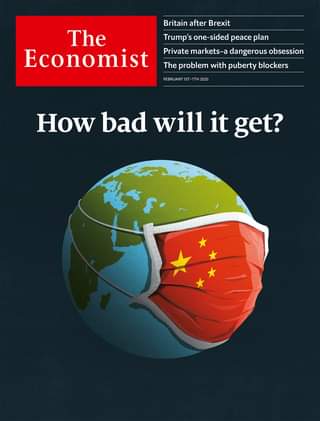China’s firm, serious approach to managing the Covid pandemic has differed from that of many other countries, and has clearly worked rather well. Yet Western media outlets feel compelled to tell China that it has slipped badly behind the times by not shifting, as they have, to Living with Covid. Seeing other (surely inferior!) societies doing far better that they are may help explain this desire to sermonize, reports Richard Cullen
THE FACTS

The Spanish Flu, which began to spread alarmingly in 1918, resulted in what is widely regarded as one of the deadliest disease eruptions in human history. Between 50 million and 100 million people died. Research by Australian Nobel Laureate and virologist, Macfarlane Burnet, concluded the evidence was “strongly suggestive” that the disease started in the United States and spread to France during World War 1.
Official public lying across America (virtually mandated by the new, US Sedition Act of 1918) comprehensively covered up this devastating public health crisis over an extended period, further aggravating the harmful outcome, worldwide.
EMERGENCE OF NEW PANDEMIC
Just over 100 years later, in December 2019, credible news appeared of what appeared to be a dangerous – and novel – flu-like illness (Covid-19). It was initially recognized in Wuhan, in China. The first reaction of certain menacing local officials was to downplay the risks and to overawe those justly warning that something very serious may be developing.
Within a short time, energized by profound concern in Beijing, this hindering approach was swept aside. The WHO and the Centers for Disease Control in the US were advised of what was known by early January, 2020. By the third week in January, China confirmed that serious person-to-person transmission was taking place. It rapidly became clear that:
- The infectiousness of Covid-19 was high;
- The mortality rate was elevated; and, most worryingly,
- Up to 15% of those infected required differing levels of hospitalization to avoid developing lethal complications.
Beijing swiftly took drastic steps to contain the spread of Covid-19, applying a lengthy lockdown of Wuhan and various other cities nearby, combined with massive travel restrictions. A most important control measure was, thus, emphatically imposed, which helped protect China – and the wider world – at a time when there were no vaccines and no specifically effective treatments.

CHINA UNDER-DEVELOPED
Professor Bingqin Li, from the University of New South Wales, reminded us in a recent article, how vulnerable China was as Covid hit. China is a fast modernizing country but it is still far from being a First World jurisdiction: it maintains only 3.6 critical care beds per 100,000 people, compared, for example, to the US and Germany, with 29.4 and 38.7 such beds per 100,000, respectively.
Professor Li emphasized how vital it was to maintain the fitness of China’s under-developed, domestic health system.
The primary Covid-control method used to secure this outcome, briefly summarized, stressed comprehensive early detection plus intense tracking and tracing (feeding into mass infection-status recording) combined with rapid hospitalization for infected cases and isolation for close contacts.
It is typically referred to as the Zero-Covid (or Dynamic-Zero-Covid) approach. [Science journals often use the phrase “elimination” strategy.] This same essential regime also continues to be applied very effectively in Taiwan and Macau – and it was used successfully in Hong Kong for over two years, until the recent Omicron outbreak gained massive traction.

SUCCESS OF ELIMINATION APPROACH
By applying some basic comparative analysis, we can get a fix on what might have unfolded had China not adopted this approach but instead had opted for a response such as that found in the UK.
- By late March, 2022, according to recorded figures, around 26% of the UK population of 67 million had contracted Covid and 165,000 persons had died.
- In China, with a population of 1.4 billion, this impact-level translates into 364 million infections and over 3.6 million deaths.
- The actual recorded figures for China, in late March, 2022 (recently boosted by an Omicron surge) stood at just 150,000 cases and 5,000 deaths.
There is, thus, a strong argument that the Zero-Covid policy adopted in China has saved several million lives and prevented hundreds of millions of infections.
“By making Zero-Covid policies work so well for so long, China conspicuously reduced the potential global Covid-variant incubation pool by possibly several hundred million persons.”
ECONOMIC PERFORMANCE
It transpires that relying on this same policy has also promoted better economic performance. In London, in September, 2020, the Times highlighted how these powerful disease control measures laid the foundations for an early normalization of production in China, with exports posting their strongest growth in 18 months, in August 2020. This was a post-Covid outcome unmatched by any other major jurisdiction.

And the benefits extend well beyond China. Experts advised that, as Covid-19 spread around the world, the original virus would mutate. The greater the number infected (close to 500 million in late-March, 2022) the greater the possibility that new variants would emerge. Two of these new variants (Delta and Omicron) have shown themselves to be highly infectious. Greater China – and especially Mainland China – by making Zero-Covid policies work so well for so long, conspicuously reduced the potential global, Covid-variant, incubation pool – possibly by several hundred million persons.
THE POLITICS
The White Man’s Media know best. In mid-October, 2021, the Economist scolded Beijing over its pandemic management policy. Many jurisdictions, they said, had moved to relax their Zero-Covid policies but China was holding out. The clear tilt in this and similar stories in the Western media, was that the likes of Mainland China (plus Taiwan, Macau and Hong Kong) had all, under this revised, media-sanctified strategy, somehow, slipped rather badly behind the times.

The Economist continued that “China has decided it does not want to live with the virus”. This was a curious claim as two weeks earlier an English language report quoted China’s top respiratory disease advisor, Professor Zhong Nanshan, explicitly discussing the opening of China’s borders. Professor Zhong spoke of the need for very high vaccination rates to be fully achieved as one pivotal prerequisite to underpin a transition to Living with Covid-19 in China.
“Across much of the Western media, the necessity of Living with Covid has widely been remodelled as a virtue.”
This move-with-the-times narrative implicitly advances the idea that the cited jurisdictions which have relaxed, have wisely done so after completing international, comparative due diligence. In fact, all the named jurisdictions that have moved to Living with Covid have done so primarily out of necessity.
In Singapore, Australia and New Zealand, for example, the authorities lost control over the spread of Covid, despite their best efforts, after the arrival of more infectious Covid variants. Across much of the Western media, the necessity of Living with Covid has widely been remodelled as a virtue.
CONCLUSION
Like a broken record, the Economist, in late March, 2022, reverted to badgering-mode, telling the world, in a special issue, that “China must eventually learn to live with Covid-19.”
[Click this link to look at scientists’ data-driven views of different strategies.]
At about the same time, the BBC, which unlike the Economist, appears to study what is actually happening, before lecturing China on what it must do, ran a lengthy story in its Reality Check series, explaining how China’s Zero-Covid strategy was changing.
This report began by noting how remarkably successful that policy had been, observing that the Covid death rate in China, with four times the population of the US and 20 times that of the UK, has seen less than 5,000 deaths, compared to almost one million deaths in the US and around 165,000 deaths in the UK.

COMMUNITY GOVERNANCE SYSTEMS
Professor Li, from UNSW, aptly observed how China’s, long-established, fine grained community governance systems have helped to provide an effective platform for applying massive and successful, rapid Zero-Covid test and trace exercises. These exercises continue but China is also now increasingly relying on isolation rather than hospitalization controls and more targeted area-based testing lockdowns.
In fact, all the Zero-Covid jurisdictions in Greater China understand that they will need, in due course, to establish effective ways to re-open their borders to the rest of the world. They know this based on well-informed, rolling assessments of how the Covid pandemic is developing – not as a result of hectoring lectures delivered by certain prominent Western media outlets. Beijing may yet be pressured by Omicron outbreaks (or other future variants) to further rework its current strategy.
Even if this happens, it remains the case that the conspicuous success of their Zero-Covid policy has:
- Saved many lives;
- Avoided placing major, additional stress on medical facilities;
- Measurably protected economies across Greater China;
- And assisted pandemic management globally.
Better still, this approach has also given these jurisdictions time to learn from others as they plan ahead with respect to when they should open-up. Time has been gained, as well, to take best advantage of vaccine and promising treatment developments.
FIRST RESPONDER
China was the first-responder to a highly contagious, deadly virus never before encountered. After a short, evasive start, Beijing quickly settled on a robust, comprehensive response. The focus radically moved to containing and controlling the spread of the virus – and to saving lives. China subsequently confirmed that this humanitarian, life-saving focus had laid robust foundations for the best economic response to the pandemic, worldwide.
What, then, has propelled the repetitive, Covid-sermonizing, directed at China, in the Western media?
One central explanation may be that, after seeing their own societies make such an extended, deadly hash of managing the Covid pandemic, the sight of certain other (surely inferior) societies doing far better has simply become very hard to bear.
Richard Cullen is a Visiting Professor in the Faculty of Law at the University of Hong Kong and a popular writer on international affairs.
This is part of a four-part look at the data of covid, showing the difference between conventional wisdom on the topic and the data. You can go to the over of the series by clicking this line.
